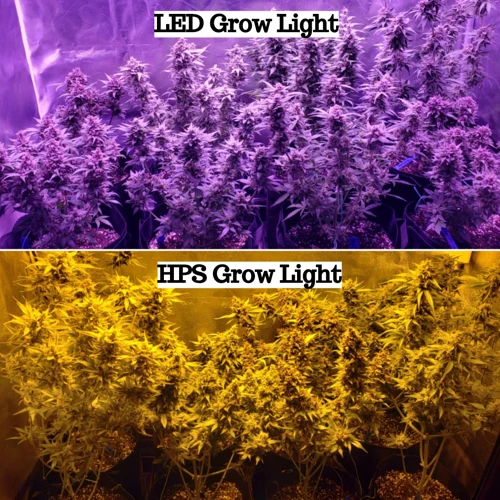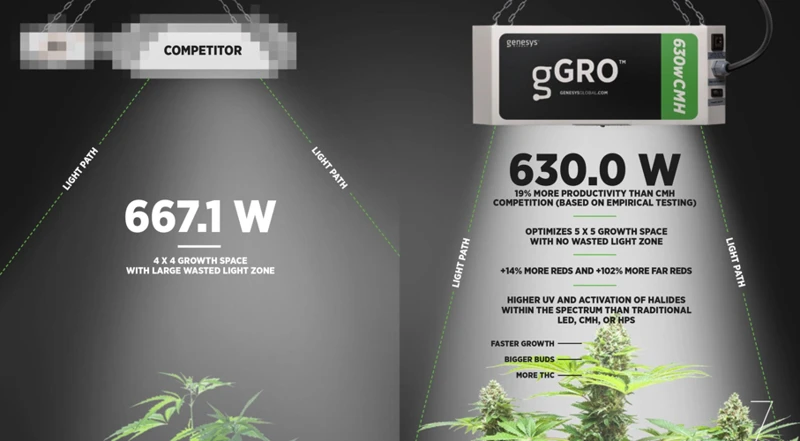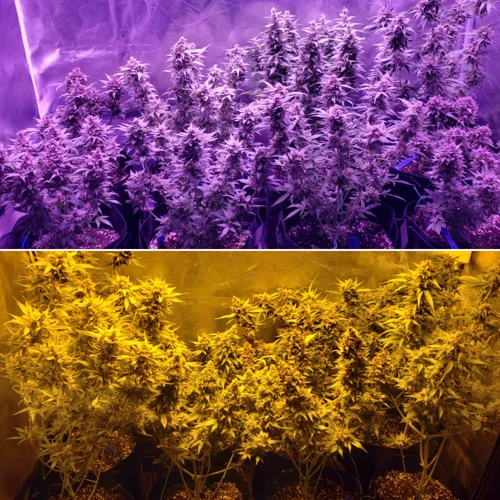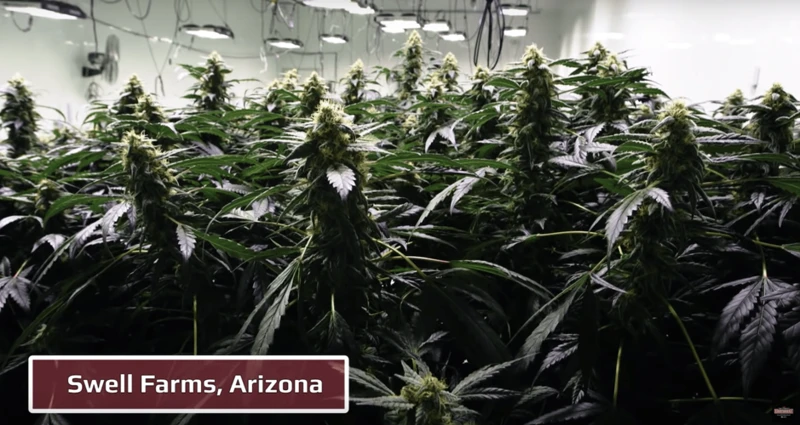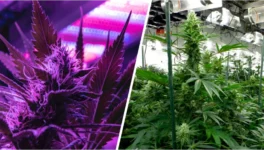
LED vs HPS Grow Lights: Which Ones Produce Better Cannabis?
When it comes to cultivating cannabis, one of the most crucial tools is a quality grow light. However, with so many different options on the market, it can be challenging to know which one is the best fit for your specific needs. Two of the most popular types of grow lights are LED and HPS. Both have their advantages and disadvantages, which can make the decision-making process even more confusing. In this article, we will explore the differences between LED and HPS grow lights, weigh their pros and cons, and help you make an informed decision on which type of grow light is right for you and your cannabis plants.
The Basics of Grow Lights
Contents
Choosing the right grow lights for cannabis cultivation is crucial to ensure the plant’s growth, yield, and potency. In this section, we will cover the fundamental aspects of grow lights that every grower needs to know. From understanding the difference between LED and HPS grow lights to knowing how to compare wattage, spectrum, and PAR output of different grow lights, we will provide a comprehensive guide to help you make an informed decision when selecting the best grow lights for your cannabis plants. Let’s dive into the basics of grow lights!
What are LED grow lights?
LED grow lights are a modern alternative to traditional HPS grow lights. They are comprised of Light Emitting Diodes (LEDs) that produce a full spectrum of light optimized for plant growth. LED lights have become popular in recent years due to their lower energy consumption and longer lifespan.
Compared to HPS grow lights, LED grow lights are highly energy efficient, emitting less heat and consuming less electricity. They also have a lower profile and generate less heat, meaning they can be positioned closer to the plants without the risk of burning or stunting their growth.
Here is a table comparing the key features of LED grow lights to HPS grow lights:
| Feature | LED Grow Lights | HPS Grow Lights |
|---|---|---|
| Energy Efficiency | High | Low |
| Spectrum | Optimized for plant growth | Yellow/orange light spectrum |
| Heat Output | Lower | Higher |
| Lifespan | Long (up to 50,000 hours) | Shorter (up to 24,000 hours) |
| Cost | Higher initial cost | Lower initial cost |
It’s important to note that LED grow lights come in all shapes and sizes, ranging from small panels to large fixtures that can cover a whole room. Their optimal usage depends on the stage of growth of the plant and the size of the area being covered.
What are HPS grow lights?
High-pressure Sodium (HPS) grow lights are a type of high-intensity discharge (HID) light that produce a strong light that is ideal for the flowering stage of cannabis growth. These lights are commonly used in commercial facilities due to their intensity and effectiveness. The table below provides further details regarding HPS grow lights.
| Advantages | Disadvantages |
| HPS lights produce a strong, high-intensity light, making them ideal for the flowering stage of cannabis growth. | These lights produce a significant amount of heat, requiring proper ventilation and cooling systems to prevent damage to plants or the grow room. |
| HPS lights have a long lifespan, usually around 24,000 hours, which makes them less expensive in the long-term for growers. | They are less energy-efficient than LED grow lights, which leads to higher electricity bills for growers. |
| They have a broad spectrum of light that includes red and orange, which are ideal for promoting plant growth and flowering. | They contain toxic materials, such as mercury, which poses a risk if the bulb breaks. |
While HPS grow lights have been the preferred choice for many growers, advances in LED technology have made them a viable option for cannabis cultivation, especially for growers who prioritize energy efficiency and want to reduce their carbon footprint. It’s essential to weigh the advantages and disadvantages of each type of grow light before making a decision on which one to use in a grow room.
Pros and Cons of LED Grow Lights
When it comes to indoor cannabis cultivation, selecting the right grow light is crucial for ensuring the highest possible yields. One option that has gained popularity in recent years are LED grow lights. While LED grow lights offer several advantages over traditional HPS grow lights, they also come with their own set of drawbacks. In this section, we’ll examine the pros and cons of LED grow lights to help you determine whether they are the right choice for your cannabis cultivation needs.
Pros
When it comes to LED grow lights, there are several pros that make them a popular choice among cannabis cultivators. Here are some of the key advantages of using LED grow lights:
| Energy efficiency: | LED grow lights are highly energy efficient and use up to 50% less energy than HPS lights. This means that they generate less heat and can help lower your overall electricity costs. |
| Long lifespan: | LED grow lights have a significantly longer lifespan than HPS lights. They can last up to 100,000 hours, compared to HPS lights that have an average lifespan of 24,000 hours. This means that you won’t need to replace your LED grow lights as often, saving you money in the long run. |
| Spectrum control: | LED grow lights offer greater control over the spectrum of light emitted, allowing you to tailor the lighting to the specific needs of your plants. This can lead to better growth, higher yields, and better quality buds. |
| Lower heat output: | LED grow lights generate less heat than HPS lights, which means you won’t need to worry as much about heat management. This can make them a good choice if you’re growing in a small space or if you’re using other types of equipment that generate heat. |
| Flexibility: | LED grow lights come in a wide variety of sizes and shapes, making them more adaptable to different growing environments. They can be used for everything from small-scale home grows to large-scale commercial operations. |
| Lower initial cost: | While LED grow lights may have a higher upfront cost than HPS lights, they generally come with a lower lifetime cost due to their energy efficiency and longer lifespan. This means that you can potentially save money in the long run by investing in LED grow lights. |
LED grow lights offer several benefits that make them an attractive choice for cannabis growers. From energy efficiency to greater spectrum control, LED grow lights can help you grow healthy, high-quality buds while minimizing your environmental impact and saving you money.
Cons
When it comes to LED grow lights, there are some potential downsides to consider. Let’s take a look at some common cons:
| Potential for Light Burn: | LED grow lights can be very intense, and if placed too close to plants, they can cause light burn which can damage or even kill the plant. |
| Expensive Upfront Cost: | While LED grow lights are very energy-efficient, they can be expensive to purchase upfront compared to other lighting types. However, this cost is often offset by their longevity and lower energy costs over time. |
| Spectrum Limitations: | While LED grow lights come in a variety of spectrums, some growers believe that they do not compare to the full spectrum produced by HPS lights, which can lead to lower yields and less flavorful buds. |
| Heat Output: | While LED grow lights are known for producing less heat than other types of lighting, they can still generate some heat, which can be a concern for larger grow operations or in warm climates where additional cooling may be necessary. |
| Less Penetration: | Some growers have reported that LED lights have a limited penetration depth compared to HPS lights, which can result in lower yields and less dense buds. |
It’s important to weigh these potential cons against the advantages of LED grow lights when deciding which type of lighting to use for your cannabis grow. Ultimately, the decision will depend on your priorities, budget, and the unique needs of your particular grow operation.
Pros and Cons of HPS Grow Lights
When it comes to choosing the right grow lights for your cannabis garden, another popular option is the HPS or High Pressure Sodium lights. These lights have been used for years and have a proven track record of success, especially for large-scale grows. However, like any grow light, HPS lights come with their own set of pros and cons that you should consider before making a purchase. In this section, we will take a closer look at the advantages and disadvantages of using HPS grow lights for cannabis cultivation.
Pros
When it comes to the pros of LED grow lights for cannabis cultivation, there are several factors to consider, including:
| Energy Efficiency | LED grow lights are more energy-efficient than HPS grow lights, meaning they use less energy to produce the same amount of light. This translates to lower electricity bills and a more sustainable growing operation. |
| Longevity and Durability | LED grow lights have a longer lifespan than HPS grow lights, with some models lasting up to 100,000 hours. Additionally, they are more durable and less prone to breakage. |
| Low Heat Output | LED grow lights produce less heat than HPS grow lights, which is beneficial for a number of reasons. First, it reduces the risk of burning your plants. Second, it means you don’t need to spend as much money on cooling systems to maintain optimal growing temperatures. |
| Customizable Spectrum | With LED grow lights, you can customize the spectrum of light your plants receive, which can be beneficial for different stages of growth. This allows you to provide your plants with the optimal lighting conditions for maximum yield and potency. |
| Low UV Emissions | LED grow lights produce very little UV radiation, which can be harmful to plants and humans alike. This means you don’t need to worry about installing additional protective measures to prevent UV damage. |
LED grow lights have many advantages over HPS grow lights for cannabis cultivation, making them a popular choice among growers looking for cost-effective, efficient, and customizable lighting solutions.
Cons
When we talk about LED grow lights, there are some downsides that need to be mentioned. While LED grow lights are a popular option for cannabis cultivation, there are some cons to consider.
One of the main disadvantages of LED grow lights is the initial cost, which is usually higher compared to other lighting options like HPS grow lights. LEDs also require a specific type of power source, meaning you may need to invest in a new power supply system to use them.
Another downside of LED grow lights is that they can be less effective at penetrating the canopy of dense cannabis plants. This means that they may not be the best choice for growers who want to maximize yields from densely packed plants.
Additionally, while LED grow lights generally produce less heat than HPS grow lights, they can still generate some heat. This heat can cause the lights to degrade over time, shortening their lifespan and potentially lowering their overall efficiency.
Finally, LED grow lights may require more maintenance than other types of grow lights. While they have been designed to last longer, they still require regular cleaning and upkeep to ensure that they are functioning properly over the long term.
To sum up, while LED grow lights are a popular choice for cannabis cultivation due to their energy efficiency and better spectrum, they also have their downsides, including higher initial cost, less penetration power and more maintenance required. Before making any decision, consider both pros and cons and choose what meets your needs and budget.
| Cons of LED Grow Lights |
| Higher initial cost compared to other lighting options like HPS grow lights |
| Less effective at penetrating the canopy of dense cannabis plants, which may result in lower yields |
| Can generate some heat, causing the lights to degrade over time and potentially lowering their efficiency |
| More maintenance required compared to other types of grow lights |
LED vs HPS Grow Lights for Cannabis Cultivation
When it comes to growing cannabis, choosing the right type of grow lights is crucial for a successful harvest. Two of the most popular options for indoor cannabis cultivation are LED and HPS grow lights. Both have their advantages and disadvantages, and it’s important to understand the differences between them before making a decision. In this section, we’ll take a closer look at how LED and HPS grow lights compare when it comes to energy efficiency, spectrum, heat output, and cost.
Differences in Energy Efficiency
Energy efficiency is a crucial factor in selecting the best grow lights for your cannabis cultivation. LED and HPS grow lights have significant differences when it comes to energy efficiency. Let’s explore them in detail in the following table:
| LED Grow Lights | HPS Grow Lights | |
|---|---|---|
| Energy Efficiency | LED grow lights are highly energy-efficient. They consume less power than HPS grow lights while producing the same amount of light. They are 60-70% more energy-efficient than HPS grow lights. | HPS grow lights consume more power than LED grow lights for producing the same amount of light. They are less energy-efficient and generate more heat, which can lead to higher electricity bills. |
As we can see, LED grow lights are more energy-efficient than HPS grow lights, which can significantly reduce your electricity bills. LED grow lights can save energy up to 60-70% compared to HPS grow lights, making them more beneficial for commercial growers who use large-scale cultivation facilities.
Differences in Spectrum
One of the primary differences between LED and HPS grow lights is the spectrum of light they emit. LED grow lights are known for providing a full spectrum of light that includes a significant amount of blue and red wavelengths. This type of spectrum is generally preferred by cannabis growers because it closely mimics natural sunlight, which is necessary for optimal plant growth and development.
In contrast, HPS grow lights emit a spectrum that is heavily weighted towards the orange and red wavelengths, with only a small amount of blue light. While this type of spectrum can promote flowering and fruiting in plants, it may not be as effective for vegetative growth.
LED grow lights can be tuned to emit specific ratios of blue and red light, allowing growers to customize the spectrum to match different stages of plant growth. This can result in more efficient growth and ultimately better yields. On the other hand, HPS grow lights do not have this tunability, which can limit their effectiveness in certain growing scenarios.
While HPS grow lights may be effective for promoting flowering and fruiting, their limited spectrum and lack of tunability may put them at a disadvantage compared to LED grow lights, which offer a more versatile, customizable spectrum.
Differences in Heat Output
The heat output is another important consideration when choosing between LED and HPS grow lights for cannabis cultivation. While both types of lights generate heat, the amount and distribution of heat can vary significantly.
LED Grow Lights Heat Output
LED grow lights generally produce less heat compared to HPS grow lights. They are designed to focus on specific wavelengths and, as a result, they emit minimal heat. LED grow lights do not require additional cooling equipment and are cooler to the touch than HPS grow lights.
However, LEDs do generate some heat and they still require proper ventilation to prevent overheating. While the heat generated by LED grow lights is lower, the heat is often more concentrated near the light source. This means that plants located directly under the LED grow light may experience more heat stress compared to plants located on the outskirts.
HPS Grow Lights Heat Output
HPS grow lights produce significantly more heat compared to LED grow lights. As a result, they require additional cooling equipment and proper ventilation to prevent overheating. The high levels of heat generated by HPS grow lights mean that they are typically used in larger grow rooms with more ventilation and air exchange.
While HPS grow lights produce more overall heat, the heat is more evenly dispersed compared to LED grow lights. This means that plants located directly under the HPS grow light may not experience as much heat stress compared to plants located on the outskirts.
To summarize, LED grow lights generally produce less heat and are cooler to the touch. HPS grow lights produce more heat and require additional cooling equipment and ventilation. However, HPS grow lights also disperse heat more evenly compared to LED grow lights. Ultimately, the heat output of each type of grow light should be taken into consideration when choosing the right type of light for cannabis cultivation.
| LED Grow Lights | HPS Grow Lights | |
|---|---|---|
| Heat Output | Low | High |
| Cooling Equipment | Not required | Required |
| Heat Concentration | More concentrated near light source | More evenly dispersed |
Differences in Initial and Long-term Cost
When it comes to initial cost, HPS grow lights are typically more affordable than LED grow lights. This is because HPS technology has been around longer and is more widely available. However, this initial cost advantage is offset by the fact that HPS grow lights consume more energy than LED grow lights, resulting in higher long-term costs.
LED grow lights may have a higher initial cost, but they are more energy-efficient than HPS grow lights. This means that in the long run, LED grow lights are less expensive to operate and can save growers money on their electricity bills.
Another factor to consider when it comes to long-term cost is the lifespan of the grow lights. LED grow lights have a longer lifespan than HPS grow lights and require less frequent replacement, which can also contribute to long-term cost savings.
It’s important to note that while LED grow lights may have a higher initial cost, the return on investment can be greater in the long run due to their energy efficiency and longer lifespan.
Ultimately, when considering the initial and long-term cost of grow lights, it’s important to factor in both the upfront expense and the ongoing operating costs.
Which One Should You Choose?
After evaluating the pros and cons of LED and HPS grow lights and understanding their differences in energy efficiency, spectrum, heat output, and cost, it can be difficult to determine which one is the best choice for your cannabis cultivation. Choosing the right grow lights is crucial for producing high-quality cannabis, so it’s important to weigh all the considerations before making a decision. Let’s take a closer look at the various factors to consider when choosing grow lights and when LED or HPS may be the better choice.
Considerations When Choosing Grow Lights
Choosing the right grow light for your cannabis cultivation can be a daunting task, as it depends on various factors. Listed below are some of the considerations you need to keep in mind when choosing grow lights for your cannabis plants:
| Consideration | Description |
| Light Spectrum | The spectrum of light emitted by the grow light plays an essential role in your plant’s growth and development. Choose a grow light that offers a spectrum close to that of natural sunlight. |
| Energy Efficiency | Before choosing a grow light, check its energy efficiency. LEDs are more energy-efficient than HPS grow lights. |
| Heat Output | Heat output is another important factor to consider. LEDs produce less heat than HPS. |
| Size of Grow Area | The size of your grow area should also be considered. If you have a small grow tent, choose a compact LED grow light for efficiency and ease of use along with a small HPS grow light. |
| Cost | Cost is a significant factor when it comes to choosing grow lights. HPS grow lights are cheaper than LED grow lights but have a shorter lifespan. |
| Noise Level | Some grow lights can be noisy, while others are silent. Consider if the noise level will be a concern for you. |
| Experience Level | Your experience level in cannabis cultivation is also important when choosing between LED and HPS grow lights. LEDs are more user-friendly and require less maintenance. |
Keeping these factors in mind will help you select the best grow lights for your cannabis cultivation and ensure better yield and growth of your plants.
When LED is the Best Choice
When LED is the Best Choice:
- Energy efficiency: If you’re looking for grow lights that consume less energy and produce better yields, then LED grow lights are the way to go. Unlike HPS grow lights, they use less energy to provide the same amount of light. This not only saves you electricity costs but also reduces your carbon footprint.
- Low heat: LED grow lights produce less heat than HPS grow lights, which means you won’t have to worry about overheating your plants or burning them. This also means that you won’t need extra cooling systems in your grow room to keep the temperature in check.
- Long-term investment: LED grow lights are a long-term investment as they have a significantly longer lifespan than HPS grow lights. They may have a higher initial cost, but you’ll save money in the long run by not having to replace them as frequently.
- Spectrum: LED grow lights provide a full spectrum of light that can be customized to suit the various stages of plant growth. This means you can adjust the light to meet the specific needs of your cannabis plants for maximum growth and yield. Unlike HPS grow lights, LED grow lights do not require a separate ballast to control intensity and spectrum.
- No need for reflectors: LED grow lights don’t require reflectors. They are designed to effectively target and penetrate through the plant canopy without the need for extra equipment.
If these considerations are important to you, then LED grow lights are the best choice for your cannabis cultivation. They offer energy efficiency, low heat, a long-term investment, spectrum customization, and no need for reflectors.
When HPS is the Best Choice
When it comes to choosing the best grow light for your cannabis cultivation, HPS grow lights can be the best option in certain situations. Here are some scenarios where HPS grow lights may be the better choice:
| Scenario | Explanation |
| High light intensity needed | HPS grow lights are known for producing high-intensity light that can penetrate deep into the plant canopy. This makes them ideal for growers who want to maximize their yields and produce larger, denser buds. |
| Large grow space | HPS grow lights are typically available in higher wattages than LED grow lights. This makes them a good choice for larger grow spaces, where high light output is needed to cover a wide area. |
| Budget constraints | While HPS grow lights may have a higher upfront cost than some LED grow lights, they can be more cost-effective in the long run. HPS bulbs have a longer lifespan than LED bulbs and can be more easily replaced when they burn out, whereas LED grow lights may require an entire fixture replacement if a component fails. |
| Blooming phase | Because HPS grow lights are rich in the red and orange spectrum, they are the preferred choice during the flowering stage of cannabis growth. This spectrum of light helps promote bud growth and flowering, resulting in bigger and denser buds. |
Ultimately, the decision to choose HPS grow lights should be based on the specific needs of your grow room and cannabis plants. Consider the size of your grow space, your budget, and the growth phase of your plants before making a decision.
Conclusion
In conclusion, choosing the right grow light for your cannabis cultivation is a critical decision that will ultimately impact your yield and plant growth. It is important to carefully evaluate the different factors, such as energy efficiency, light spectrum, heat output, and cost, before making your final choice.
LED grow lights have become increasingly popular due to their energy efficiency, low heat output, and full-spectrum lighting capabilities. However, they can be costly upfront and may require additional equipment for cooling.
HPS grow lights, on the other hand, are a more traditional option that have been used for decades in the cannabis industry. While they have a lower initial cost, they consume more energy and generate more heat.
When deciding between LED and HPS grow lights, consider your individual needs and goals. If you are looking for energy efficiency and full-spectrum lighting, LED may be the best choice. However, if you are on a tighter budget and want a more traditional option, HPS may be the way to go.
Ultimately, the decision comes down to what works best for your specific grow setup and goals. By carefully weighing the pros and cons of each option, you can make an informed decision and achieve successful cannabis cultivation.
Frequently Asked Questions
What is the difference between LED and HPS grow lights?
LED grow lights use light-emitting diodes as their source of light while HPS grow lights use high-pressure sodium gas discharge lamps.
Are LED grow lights better than HPS for cannabis cultivation?
Both LED and HPS grow lights have their advantages and disadvantages. It depends on the specific needs and preferences of the grower.
Which grow light is more energy-efficient?
LED grow lights are more energy-efficient than HPS grow lights since they consume less power and generate less heat.
Do LED grow lights produce less heat than HPS grow lights?
Yes, LED grow lights produce less heat than HPS grow lights, which can be beneficial for indoor cannabis cultivation as it decreases the need for additional cooling systems.
Which grow light has a longer lifespan?
LED grow lights have a longer lifespan than HPS grow lights. They can last up to 50,000 hours while HPS grow lights have a lifespan of 24,000 hours.
Can HPS grow lights be used for both vegetative and flowering stages of cannabis growth?
Yes, HPS grow lights can be used for both vegetative and flowering stages of cannabis growth. However, they produce more heat and are less energy-efficient.
Are LED grow lights more expensive than HPS grow lights?
Initially, LED grow lights can be more expensive than HPS grow lights. However, in the long run, they consume less power and have a longer lifespan, making them a more cost-effective choice.
What is the ideal spectrum for cannabis growth?
Cannabis plants grow best under light that has a spectrum of white light with a ratio of 3:1 red to blue light. This spectrum promotes healthy growth and high yield in cannabis plants.
Can LED grow lights be used for a large-scale cannabis cultivation?
Yes, LED grow lights can be used for large-scale cannabis cultivation. They are highly adaptable and come in a wide range of sizes and intensities.
What are some important factors to consider when choosing grow lights?
Some of the important factors to consider when choosing grow lights include energy efficiency, lifespan, initial and long-term costs, spectrum, coverage area, and heat output.

